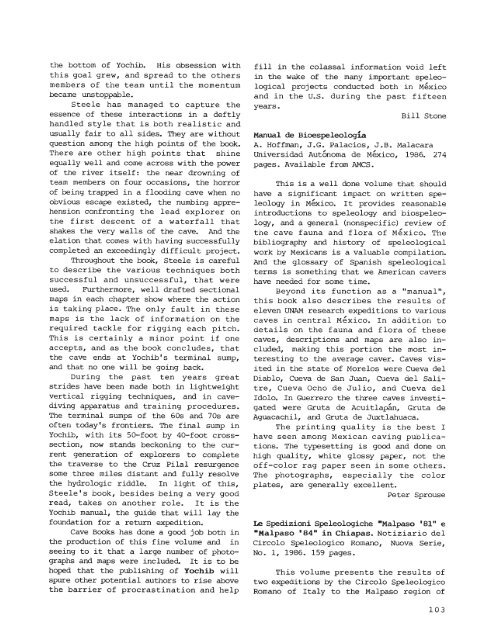8MB PDF - Association for Mexican Cave Studies
8MB PDF - Association for Mexican Cave Studies
8MB PDF - Association for Mexican Cave Studies
- No tags were found...
Create successful ePaper yourself
Turn your PDF publications into a flip-book with our unique Google optimized e-Paper software.
the bottom of Yochib. His obsession withthis goal grew, and spread to the othersmembers of the team until the momentumbecame unstoppable.Steele has managed to capture theessence of these interactions in a deftlyhandled style that is both realistic andusually fair to all sides. They are withoutquestion among the high points of the book.There are other high points that shineequally well and come across with the powerof the river itself: the near drowning ofteam members on four occasions, the horrorof being trapped in a flooding cave when noobvious escape existed, the numbing apprehensionconfronting the lead explorer onthe first descent of a waterfall thatshakes the very walls of the cave. And theelation that comes with having successfullycompleted an exceedingly difficult project.Throughout the book, Steele is carefulto describe the various techniques bothsuccessful and unsuccessful, that wereused. Furthermore, well drafted sectionalmaps in each chapter show where the actionis taking place. The only fault in thesemaps is the lack of in<strong>for</strong>mation on therequired tackle <strong>for</strong> rigging each pitch.This is certainly a minor point if oneaccepts, and as the book concludes, thatthe cave ends at Yochib I s terminal sump,and that no one will be going back.During the past ten years greatstrides have been made both in lightweightvertical rigging techniques, and in cavedivingapparatus and training procedures.The terminal sumps of the 60s and 70s areoften today's frontiers. The final sump inYochib, with its 50-foot by 40-foot crosssection,now stands beckoning to the currentgeneration of explorers to completethe traverse to the Cruz Pilal resurgencesome three miles distant and fully resolvethe hydrologic riddle. In light of this,Steele's book, besides being a very goodread, takes on another role. It is theYochib manual, the guide that will lay thefoundation <strong>for</strong> a return expedition.<strong>Cave</strong> Books has done a good job both inthe production of this fine volume and inseeing to it that a large number of photographsand maps were included. It is to behoped that the publishing of Yochib willspure other potential authors to rise abovethe barrier of procrastination and helpfill in the colassal in<strong>for</strong>mation void leftin the wake of the many important speleologicalprojects conducted both in Mexicoand in the u.S. during the past fifteenyears.Bill StoneManual de Bioespeleolog1aA. Hoffman, J.G. Palacios, J.B. MalacaraUniversidad Autonoma de Mexico, 1986. 274pages. Available from AMeS.This is a well done volume that shouldhave a significant impact on written speleologyin Mexico. It provides reasonableintroductions to speleology and biospeleology,and a general (nonspecific) review ofthe cave fauna and flora of Mexico. Thebibliography and history of speleologicalwork by <strong>Mexican</strong>s is a valuable compilation.And the glossary of Spanish speleologicalterms is something that we American cavershave needed <strong>for</strong> some time.Beyond its function as a "manual",this book also describes the results ofeleven UNAM research expeditions to variouscaves in central Mexico. In addition todetails on the fauna and flora of thesecaves, descriptions and maps are also included,making this portion the most interestingto the average caver. <strong>Cave</strong>s visitedin the state of Morelos were Cueva delDiablo, Cueva de San Juan, Cueva del Salitre,Cueva Ocho de Julio, and Cueva delIdolo. In Guerrero the three caves investigatedwere Gruta de Acuitlapan, Gruta deAguacachil, and Gruta de Juxtlahuaca.The printing quality is the best Ihave seen among <strong>Mexican</strong> caving pUblications.The typesetting is good and done onhigh quality, white glossy paper, not theoff-color rag paper seen in some others.The photographs, especially the colorplates, are generally excellent.Peter SprouseI.e Spedizioni Speleologiche -Malpaso •81" e-Malpaso •84" in Chiapas. Notiziario delCircolo Speleologico Romano, Nuova Serie,No.1, 1986. 159 pages.This volume presents the results oftwo expeditions by the Circol0 SpeleologicoRomano of Italy to the Malpaso region of103
















